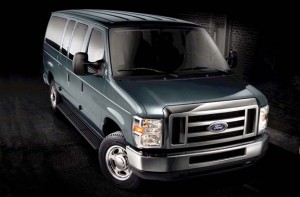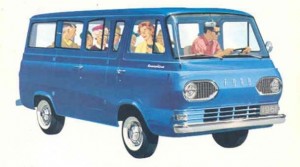You’d never know it today, when more than half the new vehicles sold are classified as trucks, and therefore command proper attention from both the media and the regulators, but half a century ago, the media and the general public paid little attention to the workhorses of the roadways.
In 1955, the big volume year of automotive production in the post-WWII decade, US factories produced 9,190,875 vehicles, of which 1,259,016 or 14 percent were trucks and buses. (In case you wondered, in that year Japanese factories turned out a total 165,000 vehicles including those classified three-wheeled,” and West Germany, 847,097.)
The big media attention in 1959 focused on the forthcoming compact cars from the Big Three, 1960-models Ford Falcon, Chevrolet Corvair and Plymouth Valiant.
But in the summer of 1960, on the eve of the 1961 model introduction, there was a sleeper: the introduction of box-like small trucks from both Ford and Chevrolet, based on the powertrains and chassis of their 1960 compact sedans.
Ford called its entry Econoline—later Falcon Econoline, probably to boost the sales count for the car–and the company’s main interest was on vans to replace panel trucks based on the F-series pickups. It was understood that the purchasing department of AT & T—Ma Bell—virtually dictated the design to Ford with the lure of volume sales to the one customer in its many entities such as, locally, Michigan Bell.
As sort of an afterthought, since the chassis and front clip would be the same, Ford also offered an odd-looking forward control Econoline pickup truck.
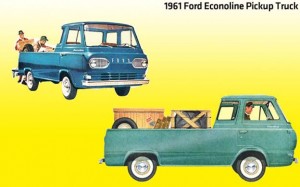
Ford thought it had another winner in the Econoline pickup, but the design failed to generate much demand and lasted only briefly.
Chevrolet concurrently introduced its 1961 Corvair 95 family of van, pickup and small bus, all based on the Corvair and to some extent, conceptually—since both had rear-mounted air-cooled engines–the Volkswagen Kombi. The van was labeled Corvan, the pickups either Rampside or Loadside depending on whether access to the box was from a drop side or conventional tailgate. The bus was called Greenbrier and unlike Ford’s “truck” Station Bus, from the beginning was treated by Chevy as a passenger car.
Since this story is about Econolines, let me just note that the Corvair trucks lasted only to the 1965 model year, replaced in 1964 ½ by the front-engine G Series, an obvious copy of Ford’s Econoline. They were joined by similar “forward control” 1964 model Dodge A-100 vans, pickups and “wagons.”
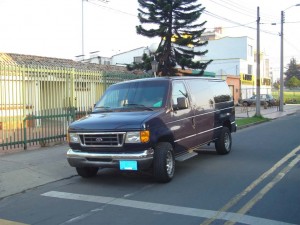
The beefy Ford Econoline lends itself to a variety of duties - an armored version, used in Columbia, is shown here.
To interject a personal note, I had joined the Ford Public Relations Staff in the summer of 1960 from Business Week, just in time to get my first PR assignment: prepare the press (as they were called then before the rise of TV) materials for 1961-model trucks, including the Econoline. And to be honest, neither I nor anyone I came in contact with, Ford or media, paid much attention to the Econoline. The big Ford attention was on a new extra-heavy line of cab-over-engine trucks, where the watchword was BBC, which stood for the critical (shortest is best) bumper-to-back-of-cab dimension to permit the longest trailer on the prevailing two-lane roads of the time, before the Interstate multi-lane highways really got underway.
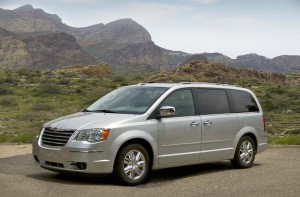
Today's minivan - which first appeared under the Chrysler badge in 1984 - stole a lot of the Econoline's thunder.
So the Econoline was the big sleeper of the year. The sleeper within the sleepers was the Econoline “station bus,” merely the van with windows in the rear sides and three rows of seats. No one noticed, no one cared, no one foresaw what a revolution on American roads was in the making. Who’d have thought there would be a big market in airport and hotel shuttle vans? Who’d have thought the attraction these ungainly boxes on wheels would have for families, displacing the familiar station wagon until Chrysler marketed the Baby Sister minivan in the 1980s.
Indeed, Ford got it wrong, too. Ford’s truck marketers figured the Econoline pickup would be second to the van in sales, but it flopped. For 1962, only 8,140 Econoline pickups were produced, versus 18,153 bus models and 50,645 vans.
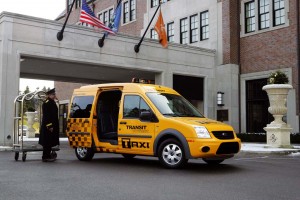
Ford's Transit Connect is slowly edging out the Ford Econoline for both personal and commercial use.
The performance of the original Econolines was pretty anemic compared to today’s vans and trucks, due to use of the Falcon 144-cubic-inch 85-hp overhead valve Six and a three-speed manual transmission with shift lever on the steering column. But the vans especially were welcomed for their economy compared to the panel deliveries based on conventional full-sized Ford passenger cars or F-series pickups.
In the meantime, there were nomenclature changes. Originally known as 1/2 –ton E-100 Falcon Econoline, the small (90-inch wheelbase, 168.4-inch overall) trucks quickly gained upgraded interiors and trims to offer an upper series Custom bus, pickup and van. For 1962, the upper series bus became Club Wagon, a name that stuck through four decades, ending with the 1998 model, according to the Standard Catalogue of Light-Duty Trucks.
Series II Econolines, introduced in 1968 1/2 as 1969 models, continued only through the 1974 model year. Three-quarter-ton E-200 and E-300 one-ton vans with standard Big Six and 302-cid V-8s were added and wheelbase grew 15.5 inches. The new designs were notable for having front engine, driveshaft and rear axle offset to the right and having twin-I-beam front suspensions adapted from F-100 trucks. Buses by now had the Chateau designation for top-of-the-line Club Wagons.
For 1975, there was another big change for Econoline. The welded, unit-body was gone, replaced by truck-like frame with body atop. The E-250 Club Wagon was offered in five, eight or twelve seat versions with up to a 460 cid V-8, on wheelbases out to 138-inches. It was no longer a small truck, but paved the way for the Econoline’s ubiquitous sight. Competition fell further behind.
About this time, the Davis family started driving Econoline Club Wagons instead of Ford or Mercury conventional station wagons. At one time, when we were building a cottage on a remote lake, we had two Club Wagons, either of which could tow the boat and carry a one-ton building-material cargo, not to mention a Golden Retriever, three teenagers and the driver duo.
Over its 50 years, Econoline unquestionably has been one of Ford’s most profitable vehicles. For the first eleven months of 2010, total Econoline retail deliveries have added up to 98,434, up 27.5 percent over the same 2009 period and well ahead of Chevrolet/GMC’s van total of 66,071. Dodge withdrew from the contest years ago.
Econolines are about the only familiar-looking “Detroit” vehicle you see south of Mexico these days. Four years ago, while traveling with a group of State- and Defense-Department-sponsored American businessmen, I even had a ride in an armored Econoline in Bogota, Columbia.
Now the Econoline–always assembled at plants in northern Ohio–is threatened by Washington’s bureaucrats and greenies and our general thirst for imported oil. Working vehicles like the Econoline come under the draconian fuel economy regulations, and the King of the road is likely to be eroded over the next few years into retirement by the small, Turkish-built imported Ford Transit Connect.
With a cutting torch, you could probably fit two Connects into one Econoline. So it goes.

